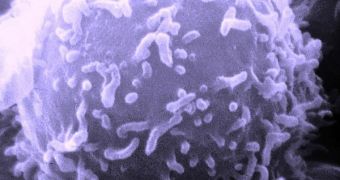A group of scientists in Northern Ireland has recently demonstrated a new approach towards fighting cancer cells. The method they developed revolves around using an innovative gene transport system for delivering a single gene inside tumor cells.
When this happens, the short bit of genetic information simply orders the affected cell to die, thus eliminating the tumor as a whole. The minuscule transport system can be recruited rather easily for a task such as this.
In a paper appearing in the February 28 issue of the esteemed International Journal of Pharmaceutics, researchers at Queen’s University Belfast explain how the mechanism operates in full detail.
The new approach has been designed specifically to fight breast cancer cells, but it could be that future tweaks to the mechanism may enable oncologists to use it against other forms of the disease as well.
According to members of the research group, the gene transport system is called a Designer Biomimetic Vector (DBV), and it consists of a single gene, packed inside a tiny nanoparticle. The particle is about 400 times smaller than the width of a human hair.
Due to this reduced size, the gene can be delivered directly inside the cancer cell, passing through the cellular defense mechanisms as if they weren't there. In lab-based experiments, the approach proved to be very effective in fighting breast cancer.
The work was conducted by Queen’s School of Pharmacy expert Dr Helen McCarthy, with funding offered through the Breast Cancer Campaign, Science Blog reports.
According to the science group, the gene used in this form of therapy is called iNOS, and it acts on breast cancer cells by forcing them to produce nitric oxide, which is a poisonous substance.
This mechanism has a two-fold action – it both kills the target cells directly, and makes the ones that resist more vulnerable to the effects of chemotherapy and radiotherapy. As an added bonus, this method does not affect healthy breast tissue around the affected area.
“A major stumbling block to using gene therapy in the past has been the lack of an effective delivery system. Combining the [DBV] with the iNOS gene has proved successful in killing breast cancer cells in the laboratory,” Dr. McCarthy explains.
“In the long term, I see this being used to treat people with metastatic breast cancer that has spread to the bones, ideally administered before radiotherapy and chemotherapy,” she concludes.
Clinical trials using the new approach may begin in as little as five years, the team says.

 14 DAY TRIAL //
14 DAY TRIAL //